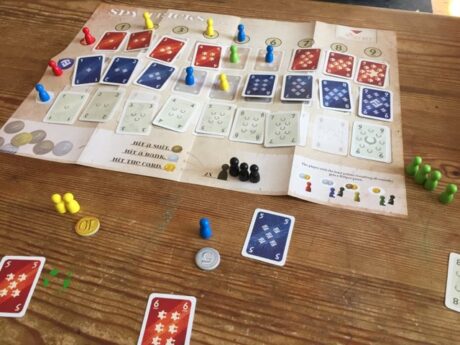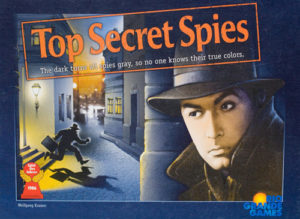- Learning time
- 10 minutes
- First play time
- 45 minutes
Spy Tricks
Designed by: Susumu Kawasaki
Spy Tricks is a card game where one card is hidden, and all the players are trying to work out what it is.
The board (actually just a sheet of paper) has a place for every card in the deck. Players are dealt six cards with the remainder laid out on the board (and one hidden!) There are three suits in ascending rank: blue beats white; and red beats blue. As cards are revealed they are added to the board, slowly narrowing down the odds on the identity of the hidden card. Spy Tricks has a roulette-like betting system: you can bet on the suit, the rank (ie all three of a certain number) or a specific card: the latter pays out the biggest returns, but is obviously more of a risk.
How the game proceeds is via simple trick-taking: a card is led by one player, and then clockwise everyone must also play a card of the same suit if they are able to, and if not dumping a lower card or trumping it with a higher one. The collected cards are the trick: all played cards are added to the board and the highest card wins the trick – the winner gets to bet by placing a pawn of their colour on the board. In Spy Tricks, however, the person who played the lowest card also gets to bet! This is a rather neat way of making a hand of apparently underwhelming cards work in your favour…
Bets can go on the aforementioned suits, ranks, or specific numbers, but once a betting space has a pawn on it, it’s considered occupied and nobody else may place pawns there, with one exception: after five hands are played if anyone hasn’t placed a single pawn they now get a free bet that is allowed to share a occupied spaces.
The hidden card is revealed and bets pay out: $2 for the suit, $5 for the rank and a juicy $10 for the correct card. A new round begins with the player (or players) in last place taking a helper pawn: these can be added to any bet in the subsequent round to double the pay-out. After a number of rounds equal to the number of players, the player with the most cash wins.
The guru's verdict
-
Take That!
Take That!
There's no arbitrary targeting here.
-
Fidget Factor!
Fidget Factor!
Low. It's not a game that invites excessive pondering...
-
Brain Burn!
Brain Burn!
...but it's not quite as straightforward as it first appears. The goal is very simple, but key to success is watching (and remembering!) what cards your opponent play, and which card you avoid playing and keep to yourself.
-
Again Again!
Again Again!
That said it isn't a game with a massive amount of variety. The rules are accessible though and there is a canniness to it that's intriguing.













Sam says
An unusual mash-up of trick-taking, deduction and roulette-style gambling. I like trick-taking games and the cleverness of Spy Tricks is in the Loser rule where the worst card in a trick also facilitates a bet. The poor soul who wins/loses nothing at all gets the free bet option as a kind of catch-up mechanism, which is a nice silver lining for someone saddled with middling cards who keeps getting beaten, but not quite badly enough. However there is a sense with Spy Tricks that the early hands are a little rote, as everyone waits for more information - in the form of cards - to appear on the board and give them a better idea of what's worth a punt. A minor gripe is the paper board - I'm not usually one to grumble about component quality if the game is fun, but it's not the ideal surface for holding cards in place. All told it's not exactly a bona fide classic, but it's a neat little game that engages enough to be worth your time.